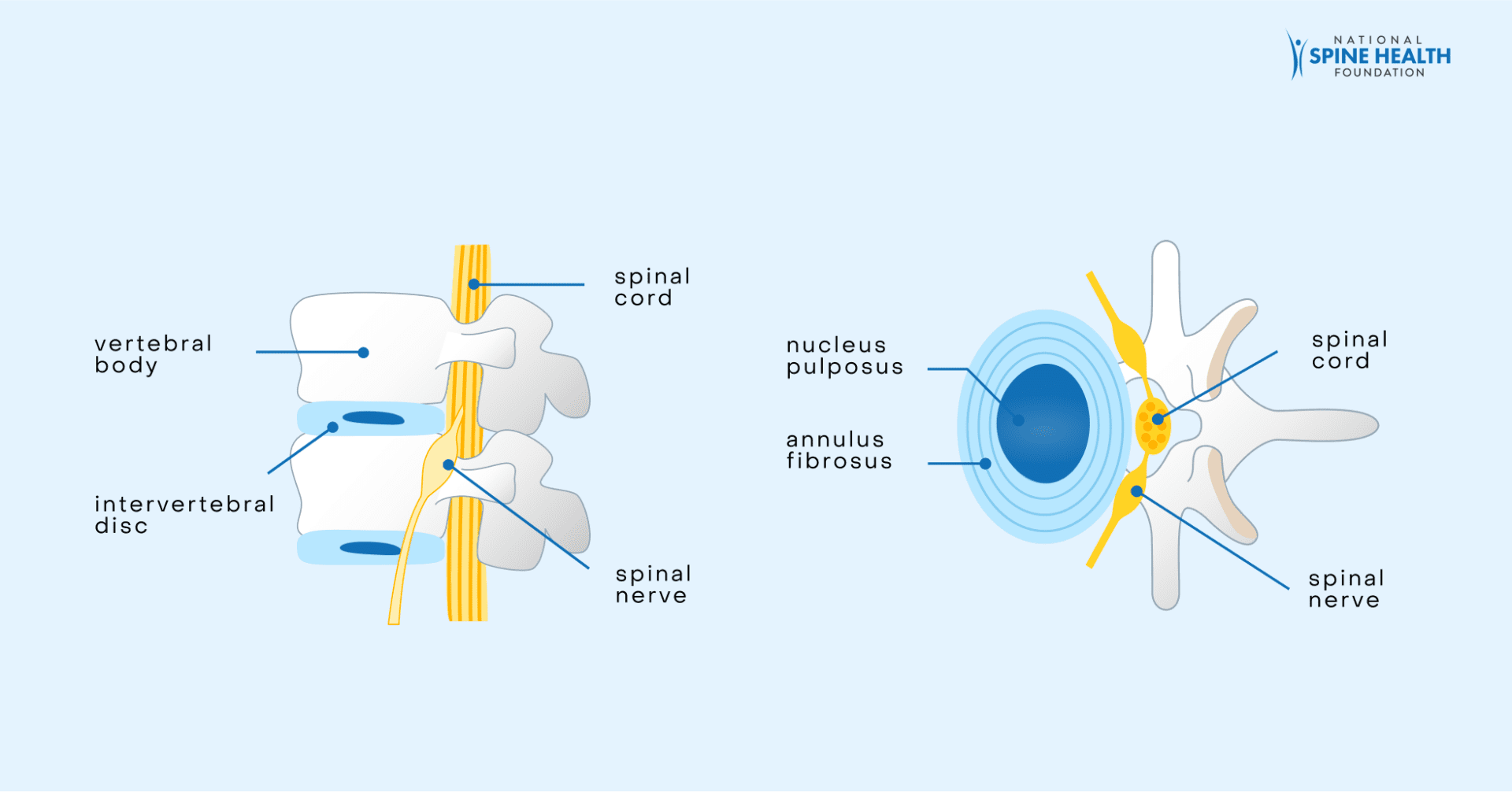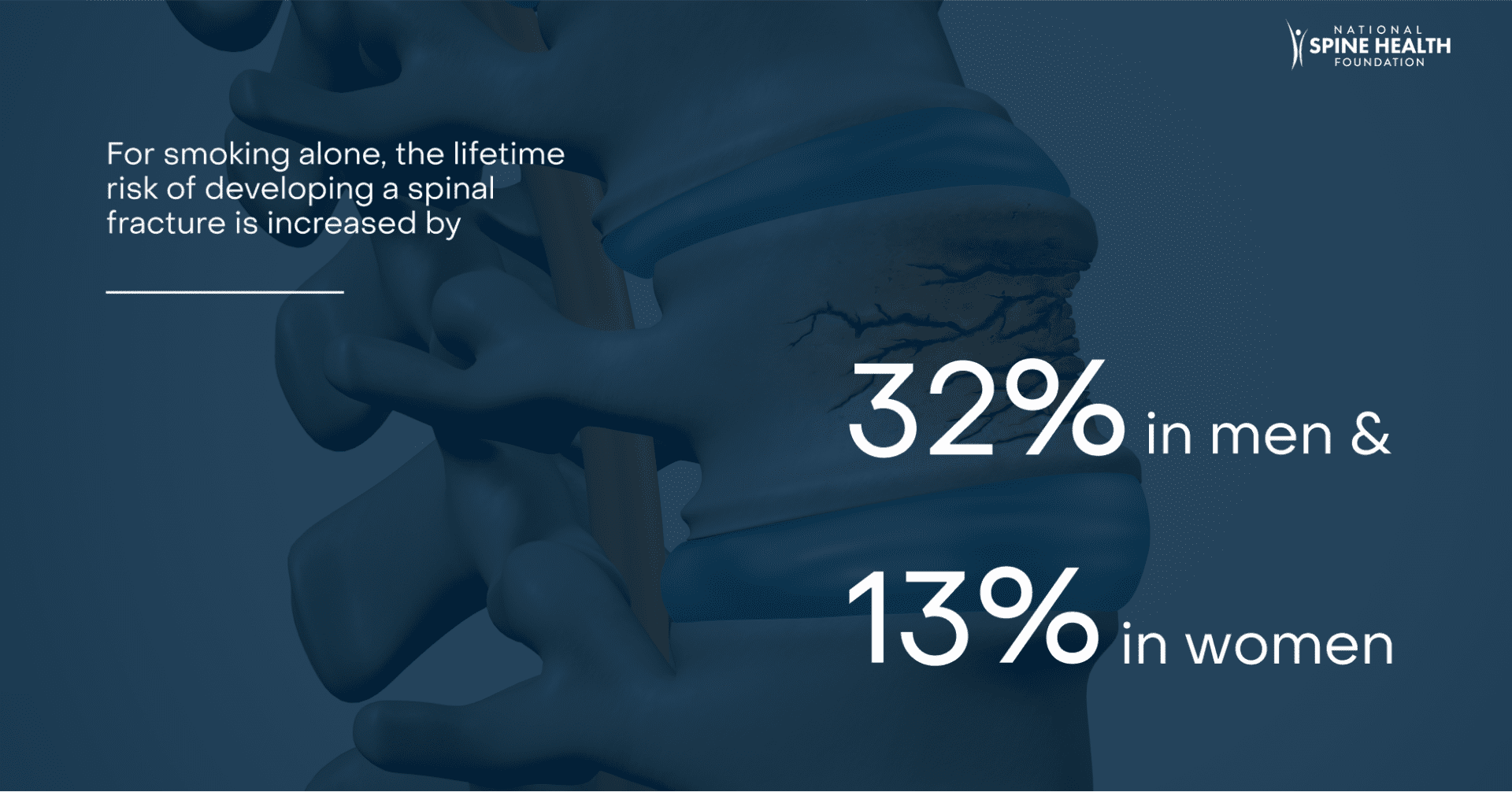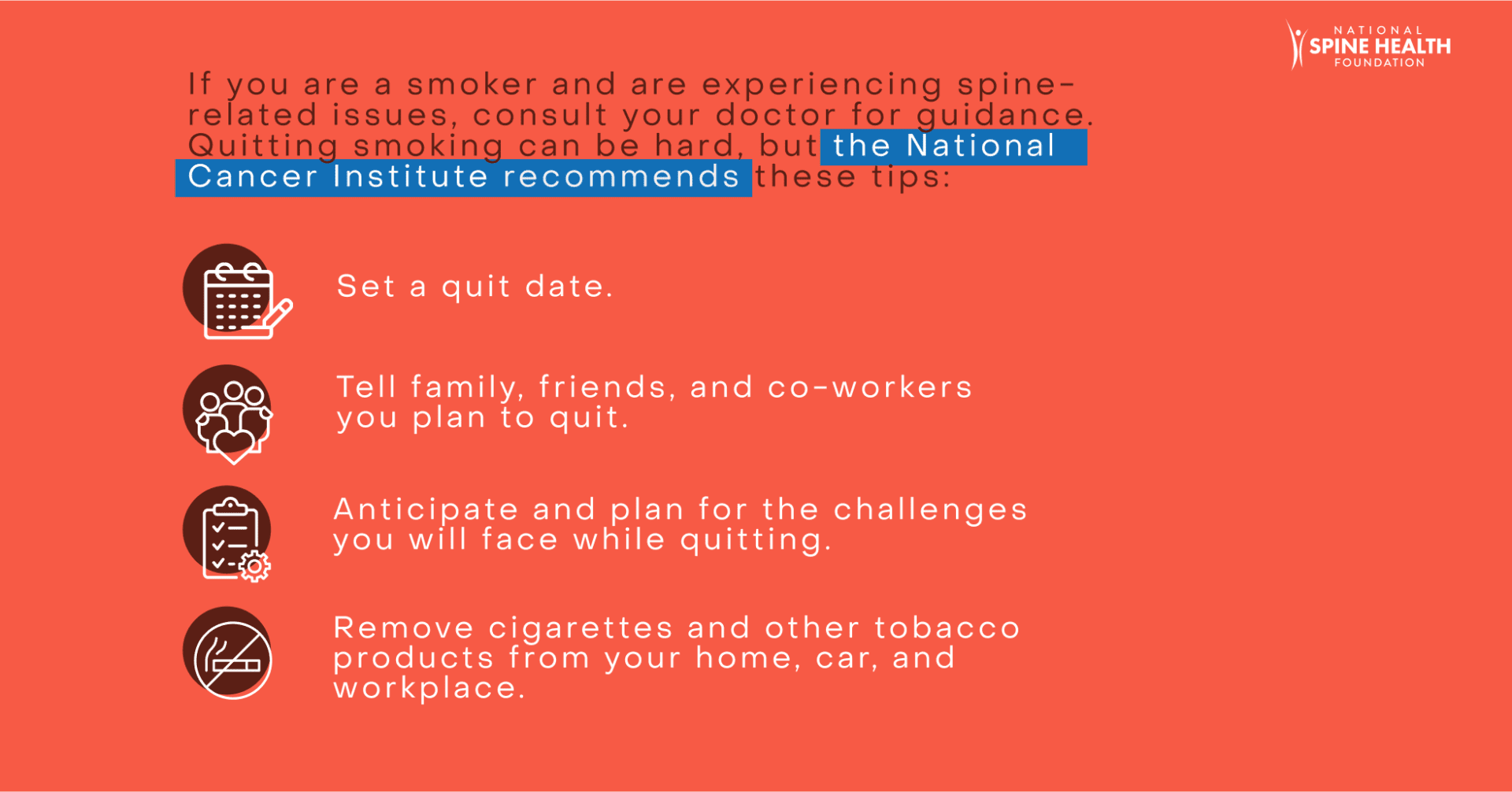People are well aware of the link between smoking and cancer and lung disease. Tobacco use remains the leading preventable cause of death, disease, and disability in the United States, and half of smokers in the U.S. will die prematurely from smoking-related causes.
But many are surprised to learn that nicotine use – like smoking and vaping – can also have debilitating effects on the spine.

The association between back pain and nicotine use in adults is well established by decades of research. Smoking and nicotine exposure can exacerbate existing back problems or increase the risk of developing them.
A 2020 study found that smoking is associated with pain in all areas of the body, but the greatest influence is on spinal pain.
How Does Nicotine Use Damage Spine Health?
Smoking and nicotine use damages spine health in many ways. One of the primary effects nicotine use can have on your back is by contributing to intervertebral disc disease (also known as degenerative disc disease). Intervertebral disc disease can manifest in various ways and is often associated with pain and discomfort.
Research has found that smokers are nearly 50 percent more likely to need spinal surgery than non-smokers. Smoking increases the lifetime risk of developing a spine fracture by 32 percent in men and 13 percent in women.
A Swedish study found that smoking increases the risk of lower back pain that needs to be fixed by spinal surgery. More than 300,000 construction workers were followed for an average of more than three decades. Heavy smokers who went through at least 15 cigarettes a day were 46 percent more likely to have this spinal surgery than those who never smoked. Moderate smokers (up to 14 cigarettes a day) had an increased risk of 31 percent, while ex-smokers had an increased risk for surgery of 13 percent.
Anatomy of the Intervertebral Discs
Imagine the spine as a stack of building blocks (the vertebrae) that are connected by strong, flexible bands (ligaments) and cushioned by soft pads (discs).

The intervertebral discs are soft, gel-like cushions that are located between the individual vertebrae of the spine. They serve as shock absorbers and provide flexibility to the spine, allowing it to bend, twist, and move.
In the human spine, there are typically 23 intervertebral discs. These discs are located between each pair of adjacent vertebrae along the entire length of the spinal column. They are vital for the spine’s overall function and play a significant role in everyday movements and activities.
The intervertebral discs do not naturally have a good blood supply. Instead, capillaries from the surface of the vertebral bodies supply the discs with nutrients. Nicotine use can accelerate the degeneration of the intervertebral discs because it reduces blood supply to the discs, making them more prone to degeneration, bulging, or herniation.
Nicotine also leads to a dehydration-like effect of these discs, causing them to lose their elasticity. In addition, nicotine contributes to inflammation in the body, which can cause the breakdown of the discs over time.
As a result, individuals who smoke are at a higher risk of developing conditions like herniated discs or degenerative disc disease.
Degenerative Disc Disease
Our spinal discs naturally degenerate over time as a part of the aging process, and disc degeneration is thought to be largely responsible for the back pain that most people experience. Degenerative disc disease is a condition where vertebral discs are weakened; they no longer properly act as cushions between the vertebrae, and instead of remaining strong, the discs become softer.
Degenerative discs typically begin with small annular tears. Just like other injuries, the tears heal by creating scar tissue, which is not as strong as the original disc wall. Over time, the process of tearing and scarring continually weakens the disc wall.
In addition, as people age, the hydrated nucleus becomes damaged and loses its water content. This fluid maintains the needed pressures to act as a functional shock absorber. The nucleus can collapse and allow the vertebral bones to slide closer together with improper alignment.
In time, improper alignment and arthritic changes can create bone spurs, herniated discs, pinched nerves, and spinal stenosis, all leading to pain.
Inflammation
Nicotine is also associated with higher levels of systemic inflammation in the body. Chronic inflammation can contribute to pain and discomfort in various parts of the body, including the back. Chronic inflammation can promote bone resorption (the breakdown of bone tissue) and hinder the body’s ability to build new bone, contributing to bone loss.
Nicotine also inflames the blood vessels, decreasing essential blood flow to all tissues, including to the intervertebral discs. This promotes the development of dangerous plaque and blood clots, and deprives the spinal discs, vertebrae, and surrounding tissues of essential nutrients and oxygen, hindering their ability to repair and maintain proper function. These processes cause discs to prematurely degenerate and become diseased.
Osteoporosis
Nicotine exposure is a risk factor for the development of osteoporosis, a condition characterized by weakened and brittle bones, including those in the spine. While nicotine alone doesn’t directly cause osteoporosis of the spine, it can contribute to its development.
Nicotine use is associated with lower bone density. The spine is particularly vulnerable to the effects of reduced bone density because it is made up of multiple vertebrae. Weakened bones in the spine are more susceptible to fractures and may result in compression fractures of the vertebrae.
Because of the widespread prevalence and increased risk for fractures, approximately one in two women and up to one in four men over 50 years old will break a bone due to osteoporosis. Spinal fractures are the most common type of osteoporotic fractures.
Even secondhand smoke has been shown to negatively affect bone mineral density. Smoking clearly has a role in increasing the loss of bone density in all bones, and the rate of loss is related to the daily number of cigarettes smoked and years of exposure.
Nicotine use also delays fracture healing. This is likely due to the fact that the toxic activity of nicotine stops the growth of cells essential for healing and reduces needed blood and oxygen supply. This is important not only for fracture healing but for any healing after a surgery.

In addition, nicotine use can impair the body’s ability to absorb essential nutrients, including calcium and vitamin D, which are crucial for maintaining strong bones. Calcium and vitamin D deficiencies are common risk factors for osteoporosis. Smoking and nicotine use can also disrupt the body’s hormones responsible for bone health, such as estrogen. In women, a decline in estrogen levels due to smoking can accelerate bone loss, which is a significant factor in the development of osteoporosis.
Muscle and Immune System Weakening
Nicotine use can weaken the muscles of the back and core, which are essential for providing support to the spine and maintaining good posture. Weak muscles can increase the risk of developing back pain or make existing pain worse.
Smokers may be more likely to adopt poor posture habits, such as slouching or hunching over, which can strain the back muscles and lead to discomfort and pain. Due to weakening muscles, smokers may be more likely to adopt poor posture habits, such as slouching or hunching over. This can strain the back muscles and lead to discomfort and pain.
Nicotine Use and Surgery
Decades of research show that smokers have significantly poorer spinal surgery outcomes than non-smokers. A 2021 study found that “smoking significantly worsens the results” of patients who underwent surgery.
Smokers experience higher rates of delayed wound healing, postoperative infections, and decreased successful spinal fusions compared to non-smokers. Smokers stay in the hospital longer. One study looked at nearly 300 spinal fusion patients and found smokers were almost three times as likely to have a nonunion (failure to completely fuse) than non-smokers. The incidence of delayed wound and fusion healing is so significant that many surgeons feel proceeding with an elective fusion surgery would not be worth the risk while the patient is still smoking.

Nicotine use can impede the body’s ability to heal itself. If someone with spine-related issues, such as a herniated disc or spinal surgery, continues to smoke, it may take longer for their body to recover, and the healing process may be less effective.
E-cigarettes and Vaping
E-cigarettes may have negative impacts on bone health, similar to traditional tobacco products. Using e-cigarettes (also known as vaping) is not a safe alternative to traditional cigarettes. The amount of nicotine in vaping is often much greater than in cigarettes. For example, one study found that one JUULpod “appears capable of delivering the nicotine equivalent to smoking about a pack of cigarettes.”
Research has found that e-cigarette users may be exposed to high doses of nicotine in addition to other chemicals.
Nicotine in e-cigarettes, like in traditional cigarettes, can constrict blood vessels and decrease blood flow and impact the delivery of oxygen and nutrients to the bones. In addition, e-cigarettes have been shown to promote inflammation in the body, which can have detrimental effects on bone health. All of these impacts can negatively impact spine health. One study even found that vaping increases the risk of spine fractures by 46 percent.

E-cigarettes have been promoted as a safe alternative to traditional cigarettes. But users should be aware that e-cigarettes could damage their bone health.
Quitting Nicotine: Do It for Your Spine
Quitting nicotine use – like smoking and vaping – can have a positive and immediate impact on spine health. When you quit smoking, blood flow improves, inflammation decreases, and the body’s ability to heal and maintain the spine is enhanced.
Complete cessation can improve the healing process, reduce postoperative complications, and decrease the hospital stay. Even stopping five to seven days before surgery favorably increases wound healing. From just days to decades after quitting, your body continues to become healthier.
If you are a smoker and are experiencing spine-related issues, consult your doctor for guidance. Quitting can be hard, but the National Cancer Institute recommends these tips:
- Set a quit date.
- Tell family, friends, and co-workers you plan to quit.
- Anticipate and plan for the challenges you will face while quitting.
- Remove cigarettes and other tobacco products from your home, car, and workplace.

Conclusion
It is important to understand the effects nicotine and cigarette smoke have on the body. In addition to bone health, smoking can contribute to pregnancy complications, heart and blood disease, respiratory disease, early menopause, gum disease, premature wrinkles, dementia and more.
Doctors and medical personnel should also understand the positive impact they can have in discussing these known facts with their patients. Numerous studies have shown that medical personnel play an important role in helping patients stop smoking. Just advising patients to stop smoking can influence nearly 3% more smokers to stop smoking (with the most dramatic effects in specialties involving life-threatening heart conditions).
The effects of nicotine use on the spine can be extremely damaging. If you are someone who has back pain or disc disease, quit now and improve your life. Your spine will thank you.



